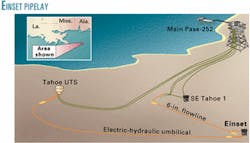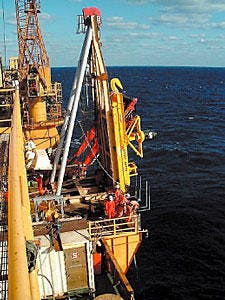A "subsea-to-subsea" installation was completed in late 2001 on Shell Exploration & Production Co.'s Einstat project by Stolt Offshore Inc., Houston. Such installations are rare, according to Stolt project manager Bjorn Koi, but may become more common for deepwater development.
The project involved a flowline and an umbilical tied between a new deepwater Einstat well on Viosca Knoll Block 872 and two existing Tahoe facilities.
Vessel record; auto welding
Koi says Stolt's Seaway Falcon multipurpose vessel achieved its deepest pipelay to date in the project and, in a single mobilization, used the J-lay installation method. Welding aboard the lay vessel employed Stolt's Serimer Dasa Saturnax automatic welding system; no welding repairs were required, according to Koi.
From Einset in 3,463 ft of water, the Falcon installed a 6-in. OD flowline 5.3 miles to the SE Tahoe 1 satellite well in 1,800 ft of water. The Falcon also installed 7.4 miles of Shell's electric-hydraulic umbilical from Einset to Shell's Tahoe umbilical termination structure (UTS) in 1,500 ft of water (map).
Stolt installed the umbilical from a reel on deck through the Falcon's flexible lay system above the vessel's moonpool. Both the SE Tahoe 1 well and Tahoe UTS facility tie back to the Shell-operated Bud Lite platform on Main Pass Block 252 in 276 ft of water.
Stolt began the fast-track Einstat project in early August 2001, mobilized its vessels and equipment by mid-October, and successfully completed the project by Oct. 31, as scheduled.
PLEMs; umbilicals
The project scope included the setting of two long base line (LBL) arrays-a collection of acoustic beacons or transponders-to ensure the accurate installation of two Shell-supplied pipeline end manifolds (PLEMs) at each end of the 6-in. flowline: one at the Einset well and one at the SE Tahoe 1 well. The two pipeline jumpers, installed by others, connected the PLEMs to the wells.
Stolt's Seaway Rover remotely operated vehicle support-and-survey vessel completed the LBL arrays, installing six transponders at Einset and eight at SE Tahoe 1 in advance of the flowline installation work.
For installing the PLEMs, Stolt designed and fabricated a purpose-built PLEM-handling frame to accommodate their size and facilitate installation. Each PLEM was approximately 25 ft tall, says Stolt, with the PLEM installed at Einset weighing 24 tonnes and the one for the SE Tahoe location weighing 18 tonnes.
Stolt installed the PLEM handling frame on the Seaway Falcon's port side (photo) to facilitate manual welding of the PLEMS to each end of the flowline, which Stolt lifted from the seabed floor to secure the pipe in the frame.
Stolt completed the welds on the deck of the Seaway Falcon and then lowered the flowline and each PLEM to the target locations at each well site for final lay down. The crew of the Seaway Falcon used the vessel's two permanently installed work-class ROVs successfully to complete the flowline and PLEM installations.
For the umbilical installation, Stolt's work included four flying leads (connections between the umbilical terminal assembly and the wellhead)-one steel flying lead at the Einset well and three thermoplastic-electrical flying leads at Shell's Tahoe UTS facility-to bring power and controls to the new well. Stolt's Seaway Rover installed a temporary parking frame at Einset to connect the flying lead to the well tree.
Other project support provided by the Seaway Rover included installation of two mud mats for the umbilical termination assemblies at Einset and installation of 10 concrete mattresses over an existing 16-in. OD pipeline for its protection. The Seaway Falcon installed the 6-in. flowline over the existing pipeline.
A separate contractor completed hydrotesting of the new flowline.
Correction
The article "Thermodynamic properties are important in predicting pipeline operations accurately" (Feb. 4, 2002, p. 56) by Mahmood Moshfeghian, Arland H. Johannes, and Robert N. Maddox was based on a presentation to the PSIG (Pipeline Simulation Interest Group) 33rd Annual Meeting, Oct. 17-19, 2001, Salt Lake City. Utah. The attribution was inadvertently dropped from the published article.




